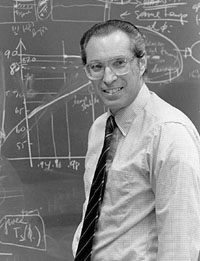 Barry Saltzman |
study of the atmosphere and climate, dies
Barry Saltzman, professor of geology and geophysics and a pioneer in the theory of weather and climate, died on Feb. 5 at age 69.
Over his productive scientific career, Professor Saltzman made several profound and lasting contributions to knowledge of the atmosphere and climate. He was one of the first to study the wave-like oscillations in the jet stream, the maintenance of the jet stream and trade winds, and the origin and development of winter storms.
His work in 1962 on thermal convection led to the discovery of chaos theory and the famous "Saltzman-Lorenz attractor." He also developed a theory of the distribution of climate on Earth, using a simple energy balance approach.
"Barry Saltzman was a leader in the field of climatology during one of its most exciting periods," said his friend and colleague Ronald B. Smith, professor of geology and geophysics. "His work brought together new observations of the Earth's atmospheric circulation with new mathematical approaches such as harmonic analysis and non-linear dynamical systems theory. His work on ancient climates showed how the diverse components of the climate system could interact to generate free and forced oscillations."
Barry Saltzman was born in New York City in 1931. After graduating from Bronx High School of Science and the City College of New York, he received his Ph.D. from the Massachusetts Institute of Technology. He moved to Connecticut in 1961, working as a senior research scientist at The Travelers Research Center in Hartford. In 1968 he became a professor at Yale, where he remained for the rest of his career.
Beginning in 1980, Professor Saltzman turned his attention to the mystery of the Earth's ancient climate, especially the problem of the ice ages. For two decades, he developed a series of models and theories of how ice sheets, atmospheric winds, ocean currents, carbon dioxide concentration and other factors work together, causing the climate to oscillate in a 100,000-year cycle. For this and other scientific contributions, he received the 1998 Carl Gustaf Rossby Research Medal, the highest award from the American Meteorological Society.
Professor Saltzman was the author and editor of numerous publications. For 23 years, he was the editor of the leading review periodical, "Advances in Geophysics." He had recently completed a new book to be published in 2001, "Dynamical Paleoclimatology" (Academic Press). In this monograph, Professor Saltzman sets forth his generalized theory of global climate change.
Professor Saltzman was a fellow of the American Meteorological Society and the American Association for the Advancement of Science. He was an honorary member of the Academy of Science of Lisbon and a member of the Connecticut Academy of Sciences and Engineering, the American Geophysical Society, the European Geophysical Society, Sigma Xi and Phi Beta Kappa.
A resident of Woodbridge, he is survived by his wife, Sheila; sister, Jean Rosenstein; and children, Matthew D. Saltzman and Jennifer A. Stasior.
T H I S
Bulletin Home
 W E E K ' S
W E E K ' S S T O R I E S
S T O R I E S![]()
 Center seeks to change views about intelligence
Center seeks to change views about intelligence
![]()
![]()
 Yale chooses architects for arts projects
Yale chooses architects for arts projects![]()
![]()
 Yale Club and Dwight Hall team up to boost volunteerism in city
Yale Club and Dwight Hall team up to boost volunteerism in city![]()
![]()
 International Health Program to be expanded
International Health Program to be expanded![]()
![]()
 Confessions of an artistic (and choc-oholic) alumna
Confessions of an artistic (and choc-oholic) alumna![]()
![]()
 Program recalls contributions of late art historian
Program recalls contributions of late art historian
![]()
![]()
 Philip Long named as director of Information Technology Services
Philip Long named as director of Information Technology Services
![]()
![]()
 Historian Kennedy describes how WWII altered the U.S.
Historian Kennedy describes how WWII altered the U.S.
![]()
![]()
 Famed actor Stephen Rea tells of his loyalty to Irish identity
Famed actor Stephen Rea tells of his loyalty to Irish identity
![]()
![]()
 Exhibit explores how artists approach use of color
Exhibit explores how artists approach use of color
![]()
![]()
 There are dinosaurs galore at the Peabody this month
There are dinosaurs galore at the Peabody this month
![]()
![]()
 Museum enjoys record-setting year
Museum enjoys record-setting year
![]()
![]()
 Future of former Yugoslavia is focus of international event
Future of former Yugoslavia is focus of international event
![]()
![]()
 Event to explore novel approaches to legal issues
Event to explore novel approaches to legal issues
![]()
![]()
 Theater in the 18th century will be the focus of international . . .
Theater in the 18th century will be the focus of international . . .![]()
![]()
 'Space Odyssey' is topic of next Tetelman Lecture
'Space Odyssey' is topic of next Tetelman Lecture![]()
![]()
 Conference will explore the impact of spirituality on health
Conference will explore the impact of spirituality on health![]()
![]()
 Professor Barry Saltzman, a pioneer in the study of the atmosphere . . .
Professor Barry Saltzman, a pioneer in the study of the atmosphere . . . ![]()
![]()
 Campus Notes
Campus Notes![]()
 |
| Visiting on Campus
Visiting on Campus |
| Calendar of Events
Calendar of Events |
| In the News
In the News |
| Bulletin Board
Bulletin Board![]()
Yale Scoreboard |
| Classified Ads
Classified Ads |
| Search Archives
Search Archives |
| Production Schedule
Production Schedule![]()
Bulletin Staff |
| Public Affairs Home
Public Affairs Home |
| News Releases
News Releases |
| E-Mail Us
E-Mail Us |
| Yale Home Page
Yale Home Page